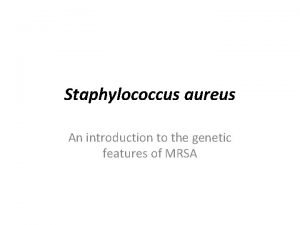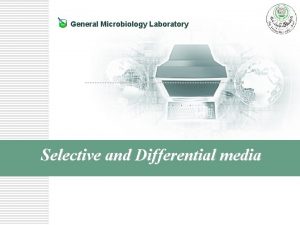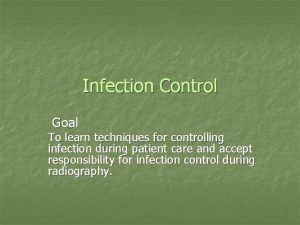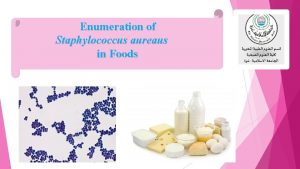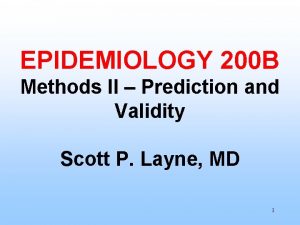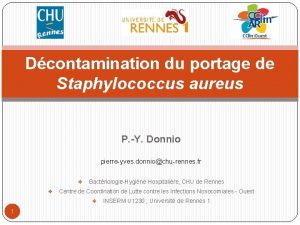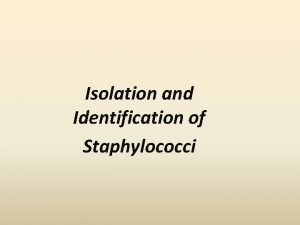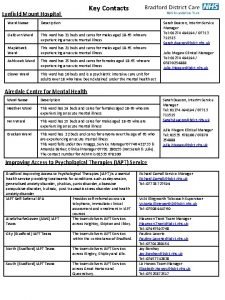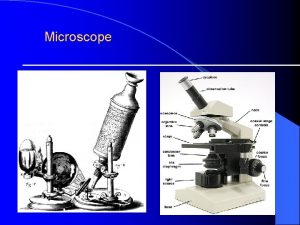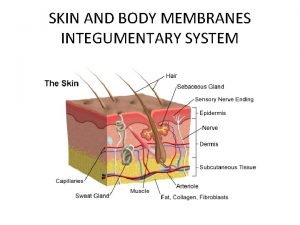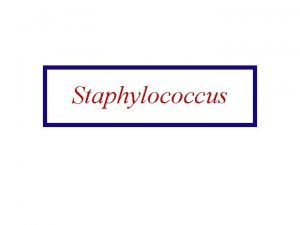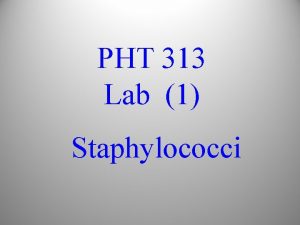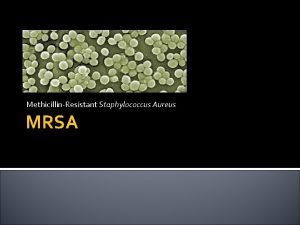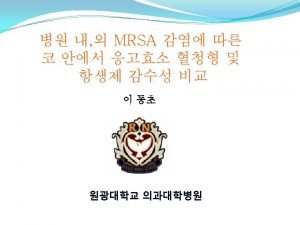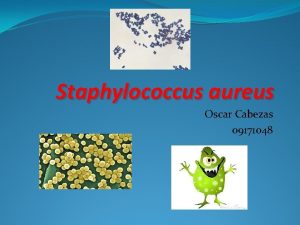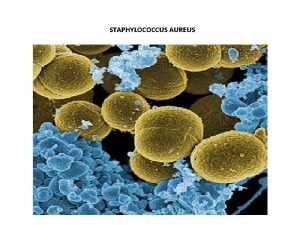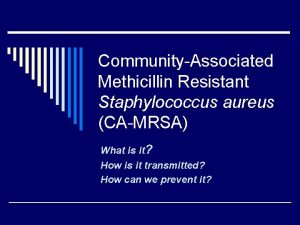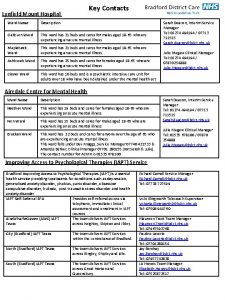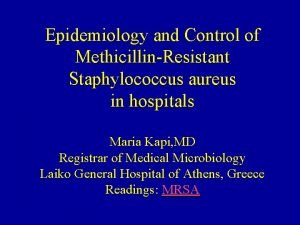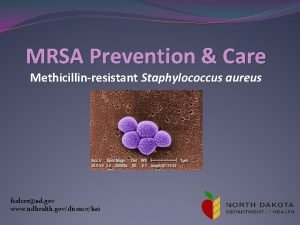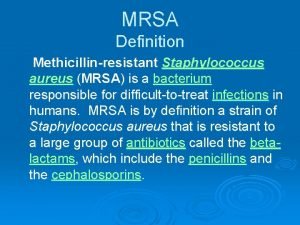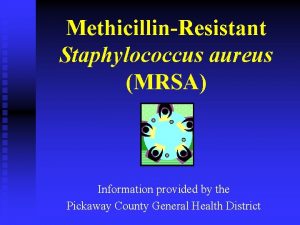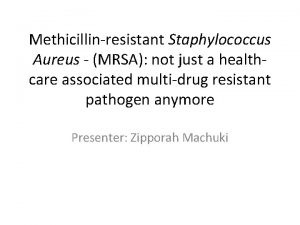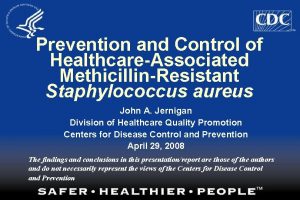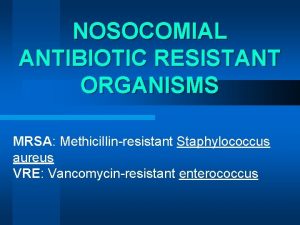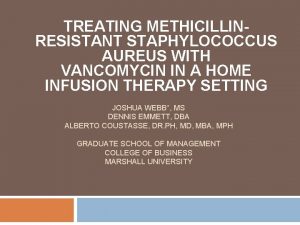CommunityAssociated MethicillinResistant Staphylococcus aureus Ruth Lynfield M D






















- Slides: 22

Community-Associated Methicillin-Resistant Staphylococcus aureus Ruth Lynfield, M. D. Minnesota Department of Health

Emergence of Resistance in S. aureus Time required for prevalence rates of resistance to reach 25% in hospitals Drug Penicillin Methicillin Year Drug Introduced Years to Report of Resistance Years Until 25% Rate in Hospitals Years Until 25% Rate in Community 1941 1 -2 6 15 -20 25 -30 40 -50 (projected) 1961 Chambers, EID 7: 178 -182, 2001 <1

Methicillin Resistance in S. aureus • mec. A confers resistance to penicillins and cephalosporins • mec. A is part of the staphylococcal cassette chromosome mec (SCCmec), a mobile genetic element (21 -67 kb in size) that may also contain genes that confer resistance to non-beta-lactam antimicrobials • SCCmec has been classified into 5 main types based on polymorphisms in its conserved genes

Staphylococcal Cassette Chromosome mec Types SCCmec type I - Archaic clone LJ D mec. R 1 pls ccr. AB 1 HVR IS 1272 RJ dcs orf. X SCCmec type IA - Iberian clone LJ Dmec. R 1 pls DHVR dcs p. UB 110 IS 1272 ccr. AB 1 RJ orf. X SCCmec type III - Hungarian clone LJ ips YTn 554 ccr. AB 3 mec. I mec. R 1 HVR p. T 181 p. I 258 Tn 554 Yccr. AB RJ orf. X SCCmec type IIIA - Brazilian clone LJ mec. I mec. R 1 YTn 554 ccr. AB 3 HVR p. I 258 Yccr. AB Tn 554 RJ orf. X SCCmec type II - NY/Japan clone LJ kdp ccr. AB 2 SCCmec type IV - Pediatric clone LJ Dmec. R 1 ccr. AB 4 IS 1272 HVR RJ dcs orf. X Oliveira et al. , Lancet ID, 2002 Tn 554 mec. I mec. R 1 HVR p. UB 110 dcs RJ orf. X 10 Kb mec. A IS 431 LJ - chromosomal left junction RJ - chromosomal right junction

Background: Healthcare-associated (HA) MRSA • Leading cause of nosocomial pneumonia, surgical wound infection, and bloodstream infection • Established risk factors include – Current or recent hospitalization – Residence in long-term care facilities – Dialysis • Typical resistance profile – Resistant to many antimicrobials in addition to beta-lactams

Community-Associated Methicillin-Resistant Staphylococcus aureus (CA-MRSA) Reports began in 1980 s of MRSA occurring in the community in patients without established risk factors – Younger patients – Indigenous peoples and racial minorities – Skin infections common – Outbreaks: • Injection drug users • Players of close-contact sports • Prison/jail inmates • Group Homes (developmentally disabled) • Men who have sex with men

CA-MRSA • Isolates typically susceptible to most antimicrobial classes other than beta-lactams • Isolates differ by PFGE from HA-MRSA • Isolates have different SCCmec types from HAMRSA • Isolates have been identified that are highly related to MSSA except for SCCmec element* • Although most infections associated with CA-MRSA have been skin and soft tissue, some infections have been very severe including necrotizing pneumonia and other life-threatening infections * Fey. Antimic Agents Chem. 2003; 47: 196 -203. Mongkolrattanothai. Clin Infec Dis. 2003: 37: 1050 -8.

CA-MRSA in Minnesota • 1997 - Minnesota Department of Health (MDH) received reports of MRSA infections in young, previously healthy individuals • Reported four pediatric deaths due to MRSA infection (MMWR, August 20, 1999)

Four Pediatric Deaths, CA-MRSA Minnesota and North Dakota, 1997 -99 Case 1 Case 2 Case 3 Case 4 Age 7 years 16 months 13 years 12 months Gender Female Male Race African American Indian White Syndrome Septic joint, pneumonia/ empyema Sepsis Necrotizing pneumonia/ sepsis susceptibility T/S, tet, cip, gent, ery, clind, vanc PFGE Clonal group A (MW 2) Clonal group A Antimicrobial

CA-MRSA in Minnesota Communicable Disease Reporting rule amended in 1999: – All cases of serious illness or death due to CAMRSA reportable – Sentinel sites were required to report all cases of MRSA

Minnesota Definition of CA-MRSA Used in Prospective Surveillance • Positive culture for MRSA obtained within 48 hours of admission (if hospitalized) • No history of hospitalization in past year • No history of surgery in past year • No history of long-term care in past year • No history of dialysis in past year • No permanent indwelling catheters or percutaneous medical devices • No prior history of MRSA infection or colonization

Minnesota MRSA Surveillance MRSA patients Healthcareassociated • Hospitalacquired • Communityonset with Risk factors (+) Medical record review Risk factors (-) Community-onset, no risk factors documented in medical record Telephone interview Risk factors (+) Indeterminate No interview Risk factors (-) Community-associated

Prospective MRSA Surveillance: Methods, MN, 2000 • 12 sentinel hospitals selected to represent different geographic regions (6 metro area, 6 greater MN) reported all cases MRSA • Patient information was collected and MRSA isolates were obtained for all cases (HA and CAMRSA) • Presumptive CA-MRSA patients were interviewed to verify that they met the CA-MRSA case definition

Minnesota MRSA Surveillance Methods: Laboratory • MRSA isolates from sentinel sites sent to MDH Laboratory • All CA-MRSA isolates tested • 25% of HA-MRSA isolates from each site randomly selected for testing • Isolates confirmed as S. aureus (tube coagulase) • Antimicrobial susceptibility testing (including oxacillin) by broth micro-dilution • PFGE subtyping • 26 CA and 26 HA-MRSA isolates characterized for toxins

Minnesota MRSA Surveillance Results: 2000 • 4, 612 patients with S. aureus identified at 10 sentinel sites in 2000 (total number S. aureus unavailable at two sites) • 1100 (25%) were MRSA (range 10 -49%) – 937 (85%) were HA-MRSA – 131 (12%) were CA-MRSA (range 4 -50%) after patient interview* – 32 (3%) not enough information to classify *13% of presumptive CA-MRSA cases were reclassified as HA-MRSA after interview

Age and Culture Sites of CA-MRSA Cases, MN, 2000 CA-MRSA HA-MRSA (n = 131) (n = 937) p-value Age (median) 23 years 68 years <0. 05 Culture site No. (%) 98 (75) 343 (36) <0. 05 Respiratory 8 ( 6) 205 (22) <0. 05 Blood 5 ( 4) 83 ( 9) NS Urine 1 ( 1) 185 (20) <0. 05 Other 10 (7) 110 (12) NS Skin

CA and HA-MRSA PFGE Subtype Patterns, Minnesota, 2000 Healthcareassociated (clonal group H) Communityassociated (clonal group A)

PFGE Relatedness of CA and HA-MRSA Isolates to Reference Strain, MN, 2000 Relatedness to Reference Strain 130 100% 120 70% 50% 35% 15% Clonal Group A 110 Number of Isolates 90% Community-associated (n=106) 100 Healthcare-associated (n=211) 90 80 70 60 50 40 30 20 10 0 0 1 2 3 4 5 6 7 8 (MW 2) Number of Bands Different from MRSA Reference Strain 9 10 11 12 13 14 15

Initial Empiric Treatment of CA-MRSA Infections, MN, 2000 (n = 92)

Susceptibility of CA and HAMRSA Isolates by Antimicrobial Agent, MN, 2000 95 94 83 79 90 80 44 16 21 9 p<0. 001 p=0. 001 92 92 96 94 100

Trends in Antimicrobial Susceptibility of CA-MRSA Isolates, MN, 1996 -2001 • No significant change in susceptibilities to tetracycline, TMP-SMX, gentamicin, or rifampin • Susceptibility decreased over time: – Ciprofloxacin: 92% to 77%, x 2 trend=15. 3, p<0. 001 – Clindamycin: 90% to 80%, x 2 trend=4. 1, p<0. 05 – Erythromycin: 70% to 39%, x 2 trend=14. 8, p<0. 001

Macrolide Resistance Mechanisms in S. aureus Macrolides (e. g. , erythromycin) Lincosamides (e. g. , clindamycin) Streptogramin B Protein synthesis erm Methylase Ribosome msr. A Efflux pump Macrolides Lincosamides Streptogramin B Macrolides
 Enzymes of staphylococcus aureus
Enzymes of staphylococcus aureus Fastidious bacteria
Fastidious bacteria Staphylococcus aureus cocci or bacilli
Staphylococcus aureus cocci or bacilli Nitrate reduction test results
Nitrate reduction test results Confirmatory test for staphylococcus aureus
Confirmatory test for staphylococcus aureus Site:slidetodoc.com
Site:slidetodoc.com Staphylococcus aureus vs streptococcus pyogenes
Staphylococcus aureus vs streptococcus pyogenes Staphylococcus aureus?
Staphylococcus aureus? Staphylococcus
Staphylococcus Enzymes of staphylococcus aureus
Enzymes of staphylococcus aureus Staphylococcus aureus
Staphylococcus aureus Etiolgia
Etiolgia Domains biology
Domains biology Staphylocoque mrs1
Staphylocoque mrs1 Are red blood cells prokaryotic
Are red blood cells prokaryotic Conjugation reproduction
Conjugation reproduction Epidermidis
Epidermidis Thornton ward lynfield mount hospital
Thornton ward lynfield mount hospital S. aureus on emb agar
S. aureus on emb agar Streptococcus aureus
Streptococcus aureus Cocci
Cocci Streptococcus aureus
Streptococcus aureus White
White
